[ad_1]
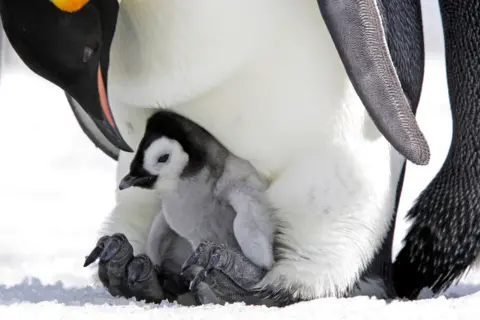 Getty Images
Getty ImagesIn May a huge iceberg broke off from an Antarctic ice shelf, drifted, and came to a stop – right in front of “maybe the world’s unluckiest” penguins.
Like a door shutting, the iceberg’s huge walls sealed off the Halley Bay colony from the sea.
It seemed to spell the end for hundreds of newly-hatched fluffy chicks whose mothers, out hunting for food, may no longer have been able to reach them.
Then, a few weeks ago, the iceberg shifted and got on the move again.
Miraculously, scientists have now discovered that the tenacious penguins found a way to beat the colossal iceberg – satellite pictures seen exclusively by BBC News this week show life in the colony.
But scientists endured a long, anxious wait until this point – and the chicks face another potentially deadly challenge in the coming months.
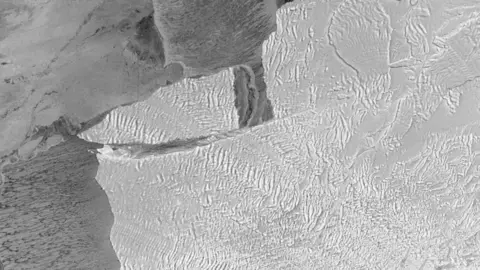 BAS Mapping and Geographic Information Centre/Copernicus Sentinel 2024
BAS Mapping and Geographic Information Centre/Copernicus Sentinel 2024In August, when we asked the British Antarctic Survey if the emperor penguins had survived, they couldn’t tell us.
“We will not know until the sun comes up,” said scientist Peter Fretwell.
It was still Antarctic winter so satellites couldn’t penetrate the total darkness to take pictures of the birds.
This label of “maybe the world’s unluckiest penguins” comes from Peter, who has shared the penguins’ ups and downs for years.
These creatures teeter on the edge of life and death, and this was just the latest in a string of near-misses.
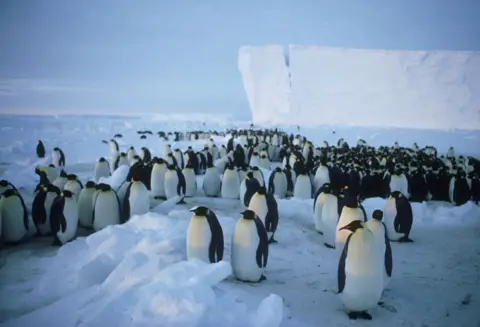 Getty Images
Getty ImagesTeetering between life and death
It was once a stable colony and with 14,000 – 25,000 breeding pairs annually, the second biggest in the world.
But in 2019, news came of a catastrophic breeding failure. Peter and his colleagues discovered that for three years the colony had failed to raise any chicks.
Baby penguins need to live on sea ice until they are strong enough to survive in open water. But climate change is warming the oceans and air, contributing to sea ice becoming more unstable and prone to sudden disintegration in storms.
With no sea ice, the chicks drowned.
A few hundred stragglers moved their home to the nearby MacDonald Ice rumples and kept the group going.
That is until A83 iceberg, which at 380 sq km (145 sq miles) is roughly the size of the Isle of Wight, carved off the Brunt Ice Shelf in May.
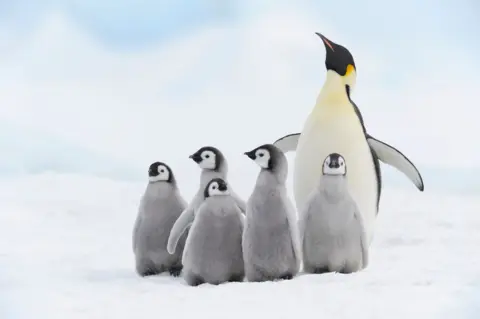 Getty Images
Getty ImagesMoment of truth for chicks
Peter feared a total wipe-out. It has happened to other penguin colonies – an iceberg blocked a group in the Ross Sea for several years, leading to no breeding success, he explains.
A few days ago, the sun rose again in Antarctica. The Sentinel-1 satellites that Peter uses orbited over Halley Bay, taking pictures of the ice sheet.
Peter opened the files. “I was dreading seeing that there wouldn’t be anything there at all,” he says. But, against the odds, he found what he hoped for – a brown smudge on the white ice sheet. The penguins are alive.
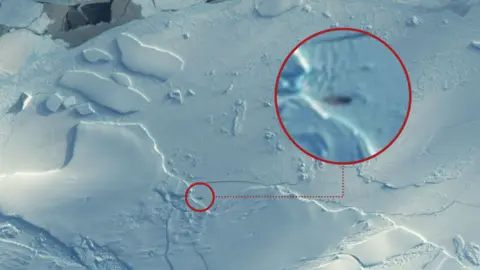 BAS/Copernicus
BAS/Copernicus“It was a huge relief,” he says.
But how they survived remains a mystery. The iceberg could be around 15m (49ft) tall, meaning the penguins could not climb it.
“There’s an ice crack, so they might have been able to dive through it,” he says.
The iceberg probably extends more than 50m beneath the waves, but penguins can dive up to 500m, he explains.
“Even if there is just a small crack, they might have dived underneath it,” he says.
More jeopardy for colony awaits
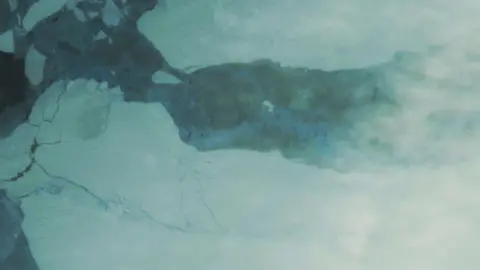 Copernicus Sentinel data processed by ESA
Copernicus Sentinel data processed by ESAThe team will now wait for higher-resolution pictures that show exactly how many penguins are there.
Scientists at the British research base at Halley will visit to verify the size and health of the colony.
But Antarctica remains a rapidly changing region affected by our warming planet, as well as natural phenomena that make life difficult there.
The MacDonald Ice rumples where the penguins now live is dynamic and unpredictable, and Antarctic seasonal sea ice levels are close to record lows.
As A83 moved, it changed the ice topography, meaning the penguins’ breeding site is now “more exposed”, Peter says.
Cracks have appeared in the ice and the edge with the sea is getting closer day-by-day.
If the ice breaks up under the chicks before they are able to swim, in around December, Peter warns they will perish.
“They’re such incredible animals. It’s a bit bleak. Like many animals in Antarctica, they live on the sea ice. But it is changing, and if your habitat changes then it’s never good,” he says.
[ad_2]

